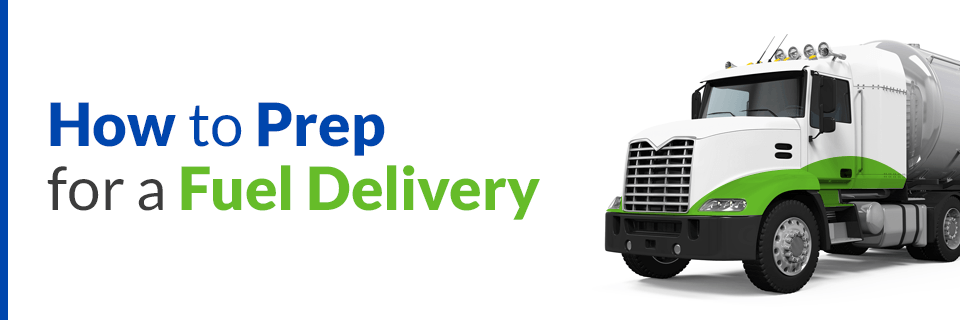
Whenever you schedule to have your oil or propane tank refilled with fuel, you are calling for a service that is not generally a DIY task. Understandably, you are putting your tank in the hands of professionals who know how to handle the task at hand. You, however, are the expert on the layout of your property and how to best navigate from your driveway to the location of your heating fuel tank.
As the homeowner, you may know your way around hazards or obstructions along the path between the entryway to your property and the area that needs service. A visiting fuel delivery person could easily stumble on these pitfalls, unaware of their presence. As a homeowner, you are responsible for the safety of your guests, including the service people who refill your tank.
Just as outbound oil and propane handlers must study safe and efficient fuel delivery tips, you must prepare for fuel delivery service. This way, your property will be safe to walk across with heavy refill equipment. Read on to learn how to prep your driveway, yard and basement for fast, efficient fuel delivery.
Prepare Your Property for Fuel Delivery
On the day of a scheduled fuel delivery service, you will need to have cleared the surrounding area and path that leads to the tank. The entire area must be safe and accessible for the heating oil delivery person. Depending on the location of your oil or propane tank, you will need to have the following parts of your property clear of hazards and obstructions.
- Driveway: You will need to keep the driveway clear for the fuel refill delivery truck. If you usually park one or more vehicles in your driveway, move those elsewhere on the day of your delivery. Suspend all other uses of your driveway in advance of the delivery service.
- Lawn: The stretch of yard that surrounds your oil or propane tank should be well-trimmed and free of dog droppings, puddles or obstructions on the day of your visit from the oil delivery person. If the tank is near a deck, clear it and inspect the boards to ensure they are safe for walking.
- Backyard: If the tank is behind your house, you will need to make your backyard accessible to the fuel delivery person. As with your front and side yards, the backyard should be accessible to walk through and cleared of garbage, dog droppings and puddles.
- Basement: If the tank is in your basement, you will need to have that area organized to give the delivery person full access on the day in question. Before your scheduled visit, this could be the perfect opportunity to clean up your basement and possibly donate or dispense with outdated fixtures and furnishings you will never use again.

Wherever your tank may be, make sure the access points are not locked on the day in question. If you have scheduled the oil or propane refill to occur at a time when nobody will be home, arrange to give the refill person full access to the necessary parts of your property.
Clear the Area Around the Tank
On the day of a scheduled fuel delivery service at your address, make sure to clear the area around your heating tank and its access points of the following possible obstructions.
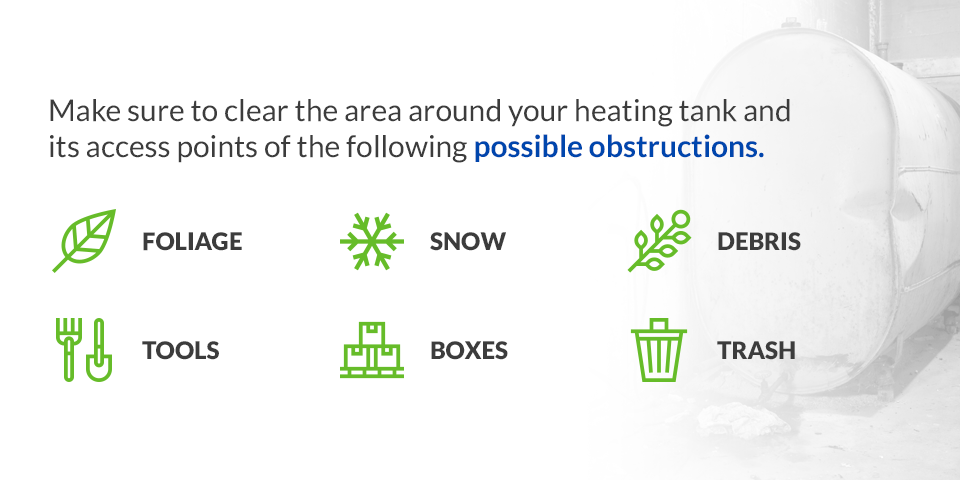
- Foliage: If you schedule a heating oil delivery in the fall or early winter, you are liable to have wet leaves pile up around the tank. If the tank is above ground, this could make access difficult. If the tank is below ground, foliage pileups could obscure the fill pipe. Clear away all foliage before the scheduled delivery.
- Snow: If inclement weather has been a factor in your area during fall and winter, your property may be under inches of snow by the time the fuel oil delivery person comes to refill your tank. Before the scheduled visit, make sure to clear all snow away from the area surrounding the tank and the fill pipe.
- Debris: Another factor of fall and winter months is debris pileup, which can result from broken branches and bush remnants. If you are less prone to do yard maintenance during the cold seasons, assorted garbage might also get blown and strewn about the location of the oil tank. Make sure to pick up all debris before your scheduled fuel delivery service.
- Tools: If you typically leave tools outside in the area surrounding the fuel tank, they could make it difficult for the service person to access the tank or fill pipe. Remove all shovels, rakes, wheelbarrows, lawnmowers or anything else that could make it difficult to reach the tank.
- Boxes: If you store crates outside your house, make sure to remove them from the tank area. If the tank is in your basement, clear all storage boxes and old furnishings away from the tank.
- Trash: If you have a habit of accumulating plastic bags full of garbage or leaves, make sure they are not near the oil tank when the delivery person arrives. The same holds for bags of trash or recyclables in your basement if that is where your tank is.
The area that surrounds your tank and the path that leads there will need to be accessible and safe to walk across with heavy equipment. Remove anything that could cause a person to slip or trip before the scheduled refill date.
Ensure the Sidewalk and Driveway Are Clear
On the day when the fuel delivery person comes to fill your tank, your driveway and the road entrances leading up to your house must be clear of the following hazards and obstructions.
- Snow: Snow can make the acts of driving, parking and walking extremely dangerous, even more so when your job entails manual fuel hauling by vehicle and foot. To ensure the oil or propane delivery person can safely and easily park near your tank and carry the fuel to the fill pipe, clear all snow away from your driveway and the roads in front of your house.
- Ice: Ice makes roads and walkways even more hazardous than snow, especially when you have to carry fuel refill equipment. If the pavement that leads to your doorsteps is icy, break it up with rock salt and shovel it away before your scheduled visit from the fuel delivery person.
- Wet leaves: Foliage along pavement can cause tires to slide and people to slip while walking. If wet leaves have piled up on your driveway or the roadside and sidewalk in front of your home, the foliage could pose a hazard to the fuel delivery person unless you rake it away before your scheduled visit.
- Vehicles: If you typically park your vehicle in your driveway, move it into your garage or park it on the roadside in front of your house on the day of your scheduled tank refill. The refill person will want to park as close to your tank as possible and should have full access to the driveway.
- Trailers, boats and bikes: If you typically park a trailer or other recreational equipment such as a boat or one or more bikes in your driveway, move them elsewhere before the fuel oil delivery person comes to fill your tank.
- Garbage bags: If the heating oil or propane delivery person will arrive on the same day the garbage collection comes through your neighborhood, do not put your trash cans or garbage bags anywhere along your driveway. Place them instead on the sidewalk, away from the driveway.
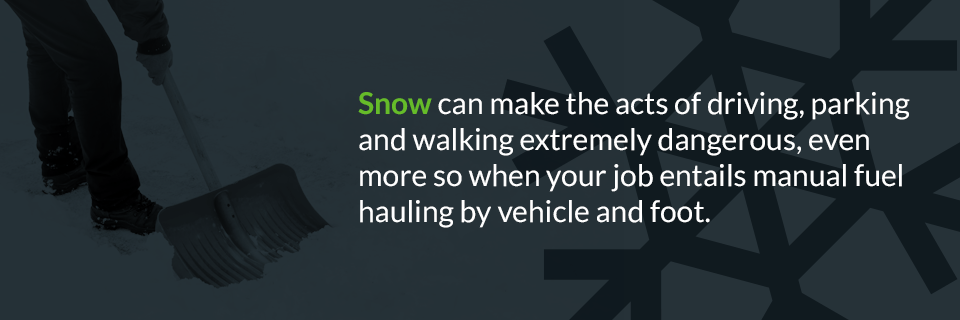
Wherever your tank is, the area in question will need to be accessible for both the fuel delivery person and the equipment necessary to carry out the task at hand.
Clear the Area of Pets and Animals
To properly prepare for fuel delivery, you will need to keep the coast clear both in front of your house and in the area that surrounds your oil or propane tank. Make sure none of the following are around these areas on the day of your scheduled fuel delivery.

- Dogs: Do not let dogs roam around outside your property when the fuel delivery person arrives at your house. If the neighbor's dog typically hangs out in your yard, ask them to keep it inside on the day of your scheduled visit.
- Stray cats: If your property has become the de facto breeding ground for wild cats, try to lead them far from your property on the day of your scheduled visit from the fuel refill person. If you usually leave out food and milk trays for these cats, remove these courtesies for the day in question.
- Wild animals: If your yard plays host to raccoons, opossums or other marsupials or rodents, steer them away from your property on the day in question. If you have chickens, sheep, goats, llamas or other exotic animals in your yard, keep them in separate quarters away from the areas the fuel delivery person will need to access.
- Children: If your kids regularly play in your driveway and the area around the oil tank, explain to them that those areas will be off-limits during the time the tank refill takes place.
- Neighborhood kids: If you usually welcome familiar neighborhood kids to play in your yard or use the basketball hoop in your driveway, explain to them that they'll need to find another place to hang out on the day of your scheduled fuel delivery. If you do not regularly talk to these kids, leave a sign in your yard or drop a line to their parents.
- Hives: If you are a professional beekeeper or allow stinging insects to form hives on your property, employ the necessary steps to make your property safe for a visiting oil delivery person.
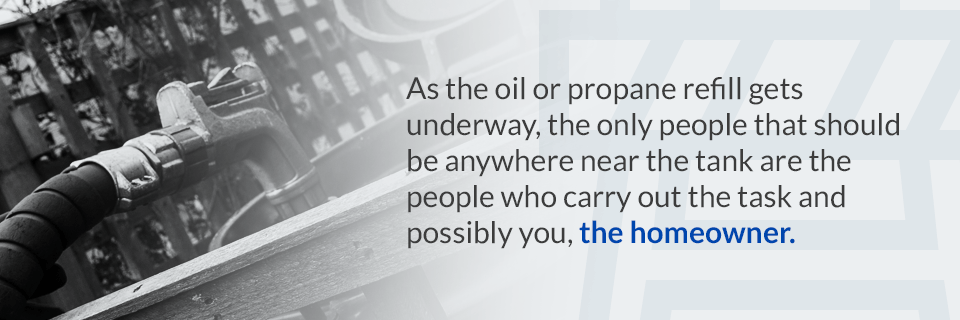
As the oil or propane refill gets underway, the only people that should be anywhere near the tank are the people who carry out the task and possibly you, the homeowner.
Know the Location of Your Tank and Its Ownership Status
In advance of your visit from the heating oil delivery person, you should know the location of the tank and clear the surrounding area accordingly. Depending on the design or layout of your property, the tank could be in one of the following areas.
- Beside your house: Oil and propane tanks are often along or near one of the side walls on a residential property. Depending on where your tank sits, you will need to have the path leading up to the tank and its fill pipe accessible on the day of your scheduled refill.
- Behind your house: On some properties, the oil or propane tank is behind the house, often near or up against the back wall. Wherever your tank may be in your backyard, keep the area around the tank clear of bags, boxes, garbage, tools and other obstructions. Make sure the path leading up to the tank is clear for the hauling of fuel refill equipment.
- Below the ground: For some property owners, underground fuel tanks are a more convenient option. If your tank is underground, identify the access points before your visit from the fuel delivery person. You will need to clear away the space leading up to the fill pipe and also remove any snow or foliage from the pipe itself before the day in question.
- In your basement: If your heating oil or propane tank is in your basement, you will need to know exactly where it is, and clear the pathway and surrounding area before the refill person arrives at your house. Be careful not to confuse the oil tank with your hot water tank.
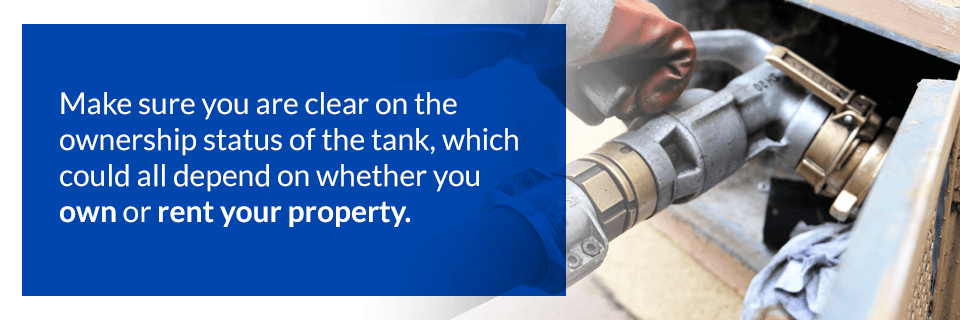
Before you schedule a fuel delivery, make sure you are clear on the ownership status of the tank, which could all depend on whether you own or rent your property.
Keep Your Tank in Safe Condition
As an owner or renter, you are responsible for the condition of your oil or propane tank. To ensure the tank remains in safe working condition, regularly check for the following hazards.
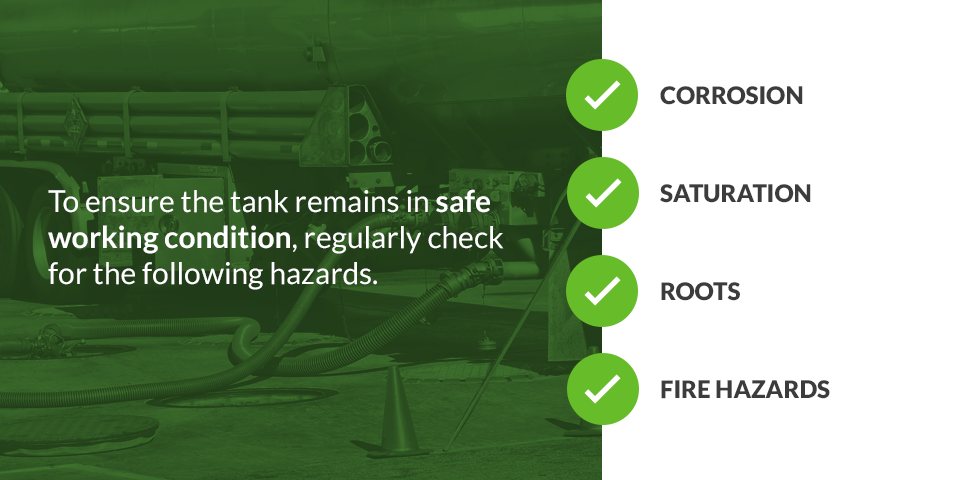
- Corrosion: The most damaging effects on a metal surface are rust and corrosion, which can spread like weeds in a lawn. If concentrations of rust grow thick along certain spots, a hole could easily form along the tank body and cause fuel to leak to the outside. Rust is the result of water evaporating on a metal surface. To prevent this from happening, make sure the metal surface of the tank remains covered. If paint starts to crack or peel, have the tank repainted.
- Saturation: If your tank is underground, it will not be vulnerable to direct rain exposure, but it could still rust and become structurally unstable if the surrounding soil becomes oversaturated. In the spring and summer, do not let the lawn above the tank to get over-irrigated. During rainy times of the year, do not allow puddles to form above or near the tank.
- Roots: Aside from soil saturation, the biggest danger to the underground tank is aggressive tree roots, which can puncture through the walls of a tank if you do not monitor tree growth on your property. If your tank is underground near a large tree, make sure tree roots will not be a problem. If you suspect this problem could be taking shape on your property, contact a local arborist for more information on how to stop the spread of roots near your oil tank.
- Fire hazards: The most dangerous threat of all to an oil tank is flammable elements. If your tank is outside above ground, never host campfires, barbecues or any activities that involve matches and lighting fluid anywhere near the tank.
If your oil or propane tank incurs external damage from accidental blunt force or vandalism, have an expert examine the damage to determine whether the tank will still be safe for further use.
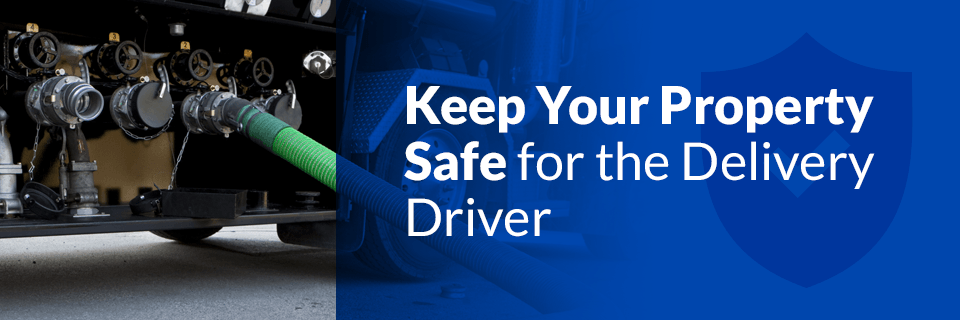
Keep Your Property Safe for the Delivery Driver
Before the oil refill person comes to your house, remove the following dangers from your property.
- Aggressive animals: If you own an aggressive pet, make sure to keep it inside for the entirety of your visit from the oil refill person. If you have wild animals in your backyard that could be dangerous to guests, keep them in isolated quarters while the refill is underway.
- Loose branches: If you schedule a propane or fuel oil delivery in the fall or winter, make sure none of the branches or overhang near the fuel tank are loose or ready to fall. If a storm has recently passed through your area, big trees will often end up with weak branches that ultimately require trimming.
- Potholes: If you have any potholes in the area around or leading up to the location of the oil tank, fill them up before the fuel refill person arrives. Remember, just because you know where to walk along your property, the same will not necessarily hold true for visiting service people.
- Traps: If you have set up rodent traps in your yard, remove them from any area where the fuel refill person might need to walk on the day in question.
- Ladders: Remove all large yard tools and equipment from the area surrounding your fuel tank. If a nearby ladder falls while the fuel refill is in progress, the refill person could get injured on your property.
Ultimately, you will want to make sure your property is as safe and accessible as possible for a quick and easy refill of your heating tank.
Heating Oil and Propane Delivery Services From Smart Touch Energy
During the colder months of the year, it is crucial to have an active and functioning heat supply. If you buy or rent a property that relies on heating oil or propane, you will need to have the fuel tank refilled on a periodic basis. As such, there are things to learn about the tank, such as its size and location on your property, as well as the type of fuel required for the system. When you know your tank, you can more easily prepare for fuel delivery and lead the service people straight to the area in question.
For homeowners and renters in states in the Northeast, Smart Touch Energy has been the leading provider of oil delivery services for 85 years. As a new customer, you can set up an online account with us to file the pertinent info about your oil or propane fuel tank, including details such as tank size and location. This way, the process of refilling your tank can be even quicker and easier each time we dispatch one of our fuel trucks to your address.





